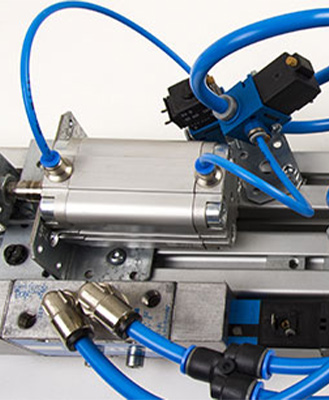How To Install Pneumatic Cylinders
Post By: Ryan King On: 30-08-2019 Read Time: 5 minutes - Guides - Pneumatics
Post By: Ryan King On: 30-08-2019 Read Time: 5 minutes - Guides - Pneumatics
Standard pneumatic cylinders are installed in much the same way as hydraulic cylinders, and the manner of installation depends on which mounting style has been chosen. Installing the cylinder correctly is a crucial consideration in the overall design and layout of your system. If you don't give it sufficient thought and planning, you can end up with a cylinder that doesn't function correctly, may not be fully reliable, and is subject to the danger of premature failure.
Depending on the specifics of your desired application, most pneumatic cylinders are going to be installed in one of two ways:
The two essential fixing points are the body of the cylinder and the piston rod end. In many machine applications, whatever mechanism is attached to the piston rod end is able to hinge in one or more planes. In some other applications, however, such as simple pushing applications, the piston rod end is left free. With special types of pneumatic cylinder such as a rodless variety, the design of the entire machine can take advantage of the cylinder's special features, but in this event you should follow the manufacturer's instructions on how to install the cylinder.

The precise mechanics of installing a pneumatic cylinder will depend on your application, as installation styles vary considerably according to application types. In any event, you should make sure when installing the cylinder to reduce any side loads on the piston rod bearing to the absolute minimum. Side loads can cause premature wear, and lead to equipment failure, as they represent a force which acts laterally across the bearing's axis, and is detrimental to the proper performance of the bearing.
There are several ways of installing a cylinder using rigid fixings on the body – with mountings on the side, or using flange plates on the front or rear end. Also, if the front or rear end cover of your cylinder has a thread, you can clamp it to another structure using a locknut. In the case of special tie rod cylinders (ISO or CNOMO type), you can fit these with tie rod extensions that enable the cylinder to be fixed through a flat plate.
Rigid cylinder mounting options include a semi-rigid trunnion version, using body supports, or pivots and clevis brackets. These permit the cylinder to rotate as it follows the extension and retraction of the piston rod during the work task.
If your pneumatic cylinder is to form part of a linkage, then it must have the ability to swivel at the mounting point in one or more planes. The cylinder and load system can achieve different degrees of balance according to whether you use a front clevis, a central trunnion or a rear hinge on the cylinder body. If you want to mount swivelling attachments at the end of the piston rod, you can use either a clevis, a front hinge, or a universal eye.
If you choose trunnion mountings, you must ensure that the cylinder is able to oscillate freely on its mountings, and that the cylinder pipe connections are able to flex naturally when in use under normal oscillation.
Finally, all bearing slides and trunnions must be properly lubricated in accordance with the manufacturer's instructions, and the entire system should then be tested before full operational use.
Before finally fitting the cylinder and putting the equipment into operation, it's wise to conduct a test using a flexible air line and a blow gun. In this way you can see that you have installed the cylinder correctly and it can move freely.
Where cylinders are being used to operate guided slides, levers and linkages, it is important that the axis of the cylinder's normal movement follows in all planes the axes of any associated guided components. Use the dial gauges on the outside of the cylinder to line up the cylinder axis.
When you have lined up the cylinder, it should be possible to move the load manually between the extremities of the piston stroke, to ensure that the slides are moving freely. If the loading and mechanical arrangement is such that you cannot operate the cylinder manually, use the blow gun at appropriate ports in order to actuate movement. The alignment will be deemed satisfactory only when the slide movement is steady and smooth. This is not a conclusive test of free movement of the cylinder under full load, but it is a good first stage check, preliminary to final load testing.
There are several areas where you need to exercise caution when installing a pneumatic cylinder:
Side loads can't usually be completely eliminated, but with simple mechanical design knowledge and good practice you can reduce them to a minimum. Knowing how to install a pneumatic cylinder correctly will ensure it gives you the best possible performance, and longest possible working life.